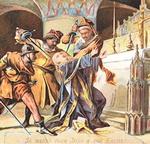Catholic Activity: La Falla de San Chusep—Saint Joseph's Day in Valencia
Italy is not the only country that claims great love for Saint Joseph. Here's an explanation of the festivities in Valencia, Spain.
DIRECTIONS
Among the many folk festivals of Spain which each year attract large numbers of tourists, Saint Joseph's Day in Valencia takes a unique position. La Falla de San Chusep, as it is called in the local dialect, has been celebrated for centuries, and it is perhaps the most spectacular, the most colorful of all Spanish holidays. It starts on March 13 and attains its gala climax six days later, after a solid week of fun and festivities.
San Chusep (St. Joseph) is the patron saint of Valencia, and since the sixteenth century his day has been celebrated by the city's artisans and craftsmen with a great deal of zest, humor, and originality. In the Valencian dialect, falla means "pyre." It seems that the term originated in the annual custom of the carpenters who cleaned their shops of shavings and discarded wood at this time of the year and burned the debris with a short ceremony. With the scraps, a comical wooden figure depicting the most inept and backward of the carpenter's apprentices was thrown into the flames. Eventually this developed into a local tradition with all the guilds participating in the burning of humorous and satirical effigies of animals, people, or subjects of local or national ridicule and scorn. Apparently the falla figures are also a product of Baroque art, with its emphasis on painting on wood, for which Valencia's craftsmen became justly famous.
Today, each guild, club, or association builds a falla of wood or papier-mâché. A queen, la reine del Falla, is chosen, and a band accompanies the queen, her court, and the falla to the contest on the main plaza of Valencia. The lavish preparations for the festival attract artists and musicians from the provinces who help the various groups build and exhibit their entries to the contest of falla During the week, bullfights are held every day. The streets are jammed with visitors admiring the fallas. In decorated booths and pavilions food and drinks are being served. And in the streets and on the city squares people dance to the music of the innumerable bands which accompany the fallas.
The best productions in art and music are judged for subject-matter and presentation and awarded prizes. The most outstanding falla is transferred to a special museum which harbors the prize winners of previous years. On March 19, at midnight, all the other fallas, some towering three stories in height, are burned in huge bonfires. Strings of firecrackers explode around the plaza, and elaborate fireworks illuminate the scene with brilliant flashes of color. As each falla crumbles into ashes, the crowds shout with glee amidst the furiously burning pyres. As the fires slowly burn down to the last embers, the merrymakers leave the scene, exhausted and jubilant, already dreaming of next year, of the next falla.
Activity Source: Festive Recipes and Festival Menus by Sula Benet, Abelard-Schuman Limited, 1970






